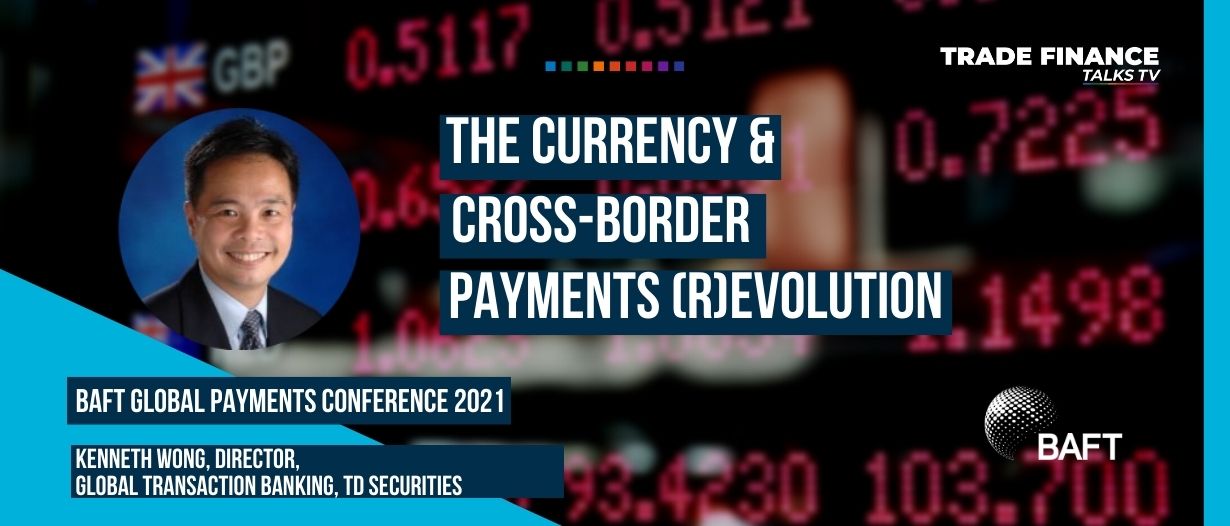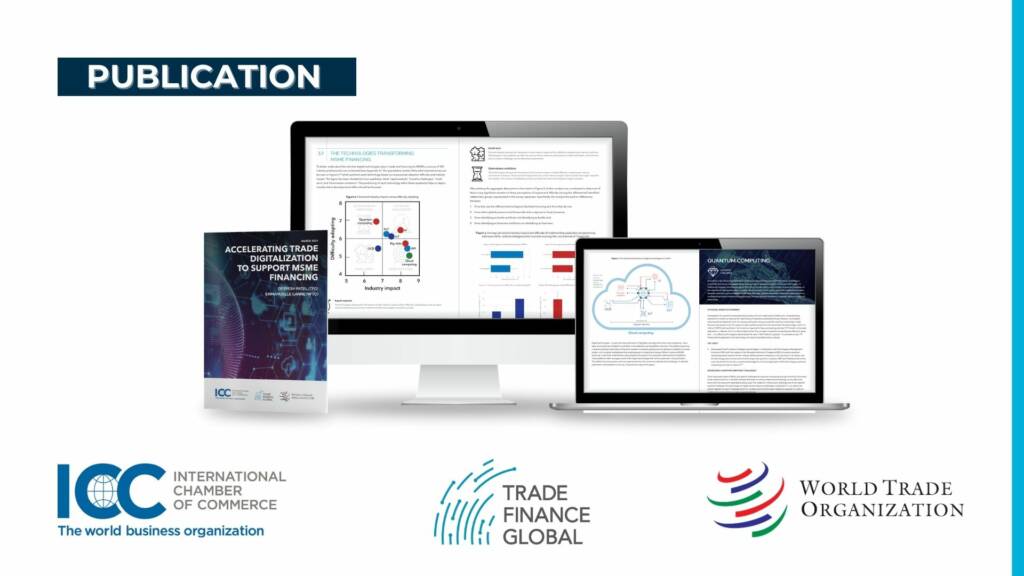Kenneth Wong, Director, Global Transaction Banking, TD Securities, talks about the changing payments landscape, cross-border payments and digital currencies.
Host: Deepesh Patel, Trade Finance Global
Featuring: Kenneth Wong, Director, Global Transaction Banking, TD Securities
The payments landscape is changing at great pace. Driven by a total shift in consumer and corporate behaviour, financial institutions, banks and technology providers are facing the need to adapt, and adapt fast.
We heard from Kenneth Wong, Director of Global Banking at TD Securities, talking cross border payments, & digital currencies.
Deepesh Patel (DP): Ken, welcome to Trade Finance Talks TV.
Ken Wong (KW): Thank you for having me.
DP: Let’s have a quick introduction and elevator pitch, in no more than 30 seconds; Who are you? Where are you from? And what do you do?
KW: I’m Ken Wong from Toronto Dominion (TD) bank. I’m based in Toronto and part of the global transaction banking (GTB) product team. I specifically look at product strategy and innovation for the global transaction bank, meaning that I look at what’s happening in the future and look for ways to enhance my client’s proposition.

Cross Border Payments
DP: Thanks, Ken. So, what are the biggest themes in payments right now? Is the huge uptake of cross-border e-commerce changing consumer and business behaviour?
KW: In my view the ‘What’ has not changed, but the ‘How’ has changed. From the ‘What’ perspective, digitization and choice have been the main themes in payments, regardless of whether it’s cross-border or domestic. Due to COVID-19, we have had to accelerate digitization in choice so that businesses and consumers could reach each other to get the commerce flow going.
There is a limit to innovation right now because of just how antiquated our present payment systems are. The traditional automated clearing house (ACH) and real-time gross settlement (RTGS) systems are not built for future innovation. Even the newer real-time rails (RTR) coming in operate much the same way as RTGS albeit 24/7/365. To really leapfrog in innovation and in the payment space, we need to change our mindset, and therefore change the operating models of how money moves.
Business and consumer wants have not changed but our ability to meet them is changing. We all just want to be able to buy from or sell to anyone in the world at a good price. That has not changed but until recently, the ability was not there to make this connection on a global basis, making payments difficult. With the advent of the internet and the creation of marketplaces, this is changing. Now, a consumer can reach any merchant around the world.
Banks adopting to an ‘always on’ world
DP: Thanks, Ken. So, it’s all about the ‘How’ is rather than the ‘What’. Let’s talk about real-time payments. As you mentioned, payment processing is moving towards a 24/7/365 approach. How does the bank need to adopt?
KW: From a real-time payment’s perspective, I see five things that a bank must look at:
1. Client access. How is the client going to access the payment system to pull money in or push money to someone else?
2. The availability of the ledger systems within the bank itself.
3. The payment engine itself. Is it running 24/7?
4. Liquidity availability. You need money in the system before you can move client money.
5. Operational availability.
Let us tackle the easy ones first. I think from a client access, payment engine availability, and operational availability standpoint, it is relatively straightforward. All banks today already run 24/7/365. This means that it is just a matter of adding another user interface (UI) to allow clients to make faster payments.
What about the payments engine? I don’t think any bank that is putting up a faster payment system is going to use any of the legacy systems. This means they will be buying new, allowing them to create anything they like, including the ability to have it available 24/7/365.
Next is operational availability. Since it is a new business scheme, you need operations to support it. Depending on the bank strategy, most will already have a 24/7/365 call centre, meaning there are already people running it. For these three factors, it is all about investment resources and operational overhead.
From a ledger perspective, things get trickier. Legacy ledger systems don’t run 24/7 and banks are unlikely to replace the ledger systems just for RTR. So how do we enhance legacy ledger systems? We might be able to use the precedence of ATM networks. ATM networks run 24/7/365 using a mirror ledger methodology for downtime. Such an approach would become a discussion around what risks the banks are willing to take or what restrictions the banks are willing to put on the client to use something like an RTR. From an ATM perspective, for each withdrawal, clients are limited to, say, $1,000, so that the bank knows its potential loss is capped at $1,000. In the bank’s off-hours, it must make a decision between accepting that risk or inconveniencing clients by limiting their transactions.
The settlement processes are different for every faster payment system – some are net settled, others are a real RTGS payment-versus-payment (PVP). What makes things more difficult too, is the funding and defunding of the liquidity within the RTRs. RTGSs are not running 24/7. During the day when the RTGS is open, I can monitor it and if I am running low on liquidity, I can pump more in. But what happens during the off-hours or the weekends? They still must monitor it just in case they run low.
The question then is what happens if we do run low liquidity for one bank? We need more mechanisms within the RTR since I cannot move money in because RTGSs are closed. Do we have a scheme of interbank lending allowing me to borrow from another bank within the system so that my transactions can still go on? This means I still need someone to monitor 24/7/365 and to have contact with other banks from within the systems to say, I have no liquidity who’s willing to lend to me and at what price and then move it within the RTR to the correct spot.

The role of FinTechs
DP: Thanks, Ken. The liquidity issue seems like a much greater issue there. On the operational side of things, is there space for FinTechs here to help the banks achieve some of those processes? Or is there an element of competition there?
KW: It is a bit of a misnomer when everyone says FinTechs are in competition with banks. In some cases, yes, but in most cases, FinTechs rely on banks. Payment FinTechs, in particular, rely on banks because they must access the payment systems. From an RTR perspective, we are talking about the official running of the actual payment system. Especially if you look in the US, there are a lot of smaller banks there that cannot afford to build up a complete infrastructure and operational shop. Instead, they outsource to process managers, like First Data, where they can run the technology and they outsource the processes to them so they can get liquidity too. From a business perspective, if the banks are running themselves operationally, why not outsource it? It should not make any difference.
Central Bank Digital Currencies
DP: Thanks very much, Ken. Moving from payments into currencies, more specifically central bank digital currencies (CBDCs). What is a CBDC? And why has there been so much interest lately?
KW: There are two types of CBDCs that everyone talks about: wholesale CBDCs and retail CBDCs. From a wholesale perspective, if you look at the money in a central bank today, it is already digital. The question is, from a wholesale perspective, especially in a domestic setting, do we really need one? The attention has gone a lot more towards the retail CBDC side. The difference between a CBDC and how we move money today is that a CBDC is a central bank liability. Whereas the money in our account and the money we move through our credit cards through the payment systems is commercial bank liability. Not central bank liability.
So, why is there so much interest? You have to look at the demographics of different countries to ask if they need a CBDC or not? One of the areas that people talk about CBDCs is financial inclusion and unbanked populations. The question then is why is a population unbanked? Is it because there are physically no banks? Is it because the population does not trust the banks, but trusts the governments? If it is the latter, a CBDC could resolve financial inclusion because it’s actually issued by the Central Bank and people are not taking a commercial bank risk.
Another area where CBDCs could be very interesting is the concept of storage of value. In countries where people do not trust the government, they tend to also not trust the currency. In some countries, people buy US dollars and hide them under their beds, because the US dollar is stable. Could CBDCs become that since they are backed by a central bank? They have the added bonus of not being physical – there are plenty of horror stories where a house burns down, and someone loses a few hundred thousand dollars because they’ve put it under their mattress. This might be a safe way to store value.
Even in developed countries, people buy T-bills because they are central bank guaranteed. CBDCs could be a form of replacement of a T-bill.
Innovation in Money Markets
DP: Absolutely, I think you’ve really got to look at where the demand is, and what the key problem is. Both from a retail and a wholesale perspective, can CBDC drive innovation in money markets?
KW: When you talk about money markets, you are talking about the debt market. This also depends on how CBDCs are implemented. For some central banks, their vision of a CBDC is that it will never pay interest. So other than doing swaps from a currency valuation perspective, why would anyone hold a CBDC from an investment perspective if it does not pay any interest? It all depends on how the CBDC is implemented. What are its features? How can I move it around? Who can I move it to? Then we could assess whether we can innovate in the money market.
The Future of CBDCs
DP: Thank you. In your opinion, what is in stock for 2021 for the future of CBDCs?
KW: When it comes to CBDCs, we are still in the learning phase. Yes, there are countries like China and Thailand that have implemented CBDCs on an experimental basis but if you look at all the other countries around us, whether the US, Canada, or the UK, everyone is still studying it to determine if there is really a use case. There is potential for CBDCs to help us bridge the innovation plateau but what that would mean is that the central banks have to get together and design a CBDC that’s fully interoperable. Then we can really innovate from a payment, collections, and even investment perspective. Until that happens, we will not see too many CBDCs going to full distribution, not in 2021 at least.
DP: Thank you, Ken. Clearly optimistic but also cautious. That piece on driving collaboration and interoperability is incredibly important when you are considering CBDCs.
Ken, I’m afraid that’s all the time we have but thank you for joining me on Trade Finance Talks TV. It has been a pleasure and we look forward to the rest of the BAFT Global Payments Conference.
KW: Thank you for having me.
 Australia
Australia Hong Kong
Hong Kong Japan
Japan Singapore
Singapore United Arab Emirates
United Arab Emirates United States
United States France
France Germany
Germany Ireland
Ireland Netherlands
Netherlands United Kingdom
United Kingdom





























Comments are closed.